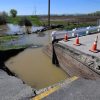The National Weather Service (NWS) offices across the US are facing a severe disruption in their ability to track extreme weather events due to Twitter’s new post-viewing limits. This development has left them unable to receive tweets from storm spotters, which are critical for tracking severe weather conditions.
The NWS Boulder office in Colorado announced on July 4 that it was unable to access most tweets due to Twitter’s new limits, which were implemented as part of Elon Musk’s changes to the platform’s usability. “We are unable to access most tweets at this time,” the office stated. “Send reports to our other social media accounts or direct through our email/phone lines.” The office also provided an alternative method for storm spotters to report severe weather conditions to the NWS.
The NWS Wakefield office in Virginia also faced similar issues, announcing that it may be unable to see tweeted reports of severe weather and associated damage due to the new viewing limits. The office directed users to contact them directly with any reports of severe weather. The Wilmington, North Carolina, office tweeted the same message, asking users to submit their severe weather alerts to a Google Form instead.
In response to a user’s query, the Wakefield office replied that it had tried accessing Twitter through the website and a PC, but it did not work. The office, along with other NWS offices, is now relying on alternative methods to receive storm reports and disseminate watches and warnings.

Musk’s changes to Twitter’s usability have imposed a viewing limit on most users, restricting unverified accounts to viewing 600 tweets a day. The limit was increased to 1,000 tweets a day a day later. The national office of the NWS said that Twitter’s new limits serve as a reminder for people to have multiple ways of receiving weather information and alerts.
The tweets about the NWS offices’ difficulties on Twitter sparked a backlash against Musk and Twitter, with some saying the change was potentially life-threatening. A TV news producer in Denver wrote, “This is dangerous, @elonmusk. Thousands of people in Colorado depend on information from the National Weather Service in times of severe weather to stay safe. There must be another way to fix whatever you deemed to be wrong at Twitter.”
Another user wrote, “As a storm chaser I have communicated with federal agencies as well as news companies in both the US and Canada through the years, and Twitter is by far the easiest way to do this. Twitter is a major tool in helping warn the public of dangerous weather conditions and a collapse or severe degradation of the website is going to ultimately end up with somebody being killed.”

